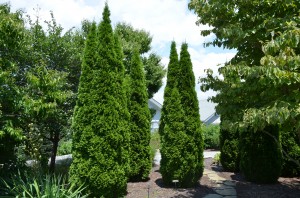Emerald™ or ‘Emerald Green’ arborvitae (Thuja occidentalis ‘Smaragd’) is not new shrub or cultivar. More than 3 generations of gardeners have used this unique form of eastern arborvitae as their “go to” evergreen shrub up and down the eastern coast and through the Midwest (USDA hardiness zones 3-7). Emerald is a semi-dwarf evergreen shrub with a compact, narrowly pyramidal habit.
Emerald arborvitae differs from 12-15 feet high and 4-5 feet wide at maturity. A row of these “cookie cutter” shrubs shows very little variability as a lovely privacy hedge or foundation planting. Leaves are glossy, bright green, and scale-like in flattened sprays. Color rarely bronzes off in a cold winter in east Tennessee (zone 6). Urn-shaped ½ inch long cones turn reddish brown in late autumn.
Eastern arborvitae grows in any well-drained soil in full sun or part shade. Deep watering is highly recommended over long summer dry spells. This conifer struggles on a poorly drained site. Foliage is more open (less tight) when planted on shady sites. Under southeast U.S. heat and humidity Emerald arborvitae excels, far better than the species.
Feed in late winter with a slow release fertilizer specially designed for evergreen shrubs such as Osmocote™, Nutricote™, or Schultz Nursery Plus™. Add to organic mulch in the spring. Prune arborvitaes in late winter before onset of new spring growth. Remove broken branches and inspect hedges for possible bagworm infestations.
The tightly bundled branches may break apart under excessive ice and snow loads. Arborvitaes are rarely troubled by disease or pest problems and are quite tolerant to air pollutants in large urban centers. Bagworms and spider mites are occasional insect pests. Protection against deer browsing is imperative.


 Posted in
Posted in 
